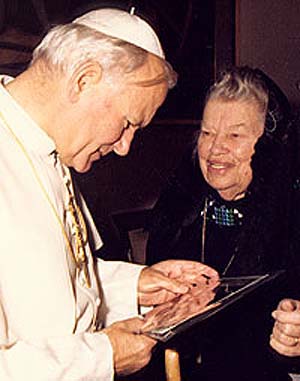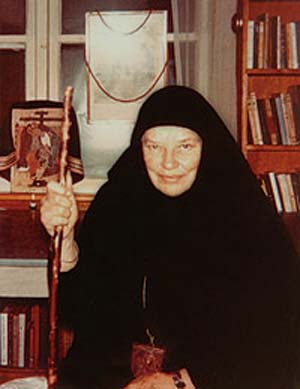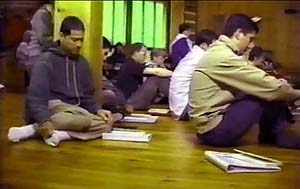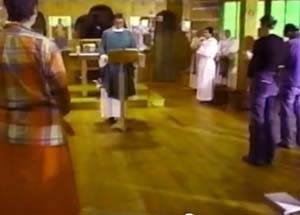 |
Ecumenism
The Spirit of Madonna House - Part I
Its Founder Promotes Ecumenism
'Inspired by the Spirit'
Dr. Carol Byrne
Madonna House today, as Trudi Lawrence has shown, is most clearly a full-blown ecumenical organization based on a Socialist platform. To understand why this is so, we need to investigate its origins and its founding principles.
Madonna House was founded by Catherine de Hueck Doherty and her husband Eddie in Combermere, Ontario, in 1947 as a charitable institution to help the poor and disadvantaged members of society. It was an extension of the kind of work that Catherine, a Russian émigré, had been doing in Canada and the US since she left Russia in 1917. Catherine regarded it as her spiritual “apostolate,” and the members of Madonna House – both clerical and lay – still see themselves as striving to live the teachings of Christ by forming a charismatic “community of love”.

Founder Catherine Doherty receives a warm reception from JPII |
Madonna House has become one of the many lay “ecclesial movements” that have been the darling of the Popes since Vatican II: you name it, they’ve blessed it, together with their wild and wacky liturgies [see here and here]. They were all instruments in advancing the progressivist agenda in one or more of the following key areas: lay leadership, women’s roles in administration, priestly formation (1) and sacramental life, liturgical reform, inter-faith sharing and ecumenism.
One can think of many epithets for these movements – naturalistic, subversive, uncatholic come to mind – but what appears to make them qualify as bastions of excellence in the minds of the Popes is that they embody the novelties of Vatican II. It is noteworthy that Madonna House – and its predecessor, Friendship House – had been going full steam ahead for decades prior to Vatican II in exactly the kind of innovations sanctioned by the Council.
As we shall see, Catherine was a pioneer in all these areas, for which she has been rewarded, on a par with Dorothy Day (with whom she shared much in common) with the title “Servant of God,” the first step towards canonization.
The account of Catherine’s putative “sainthood” by her postulator, Fr Bob Wild, makes devastating reading and contains certain elements that are far more alarming than might at first appear.
Ecumenism 'inspired by the Spirit'
Take ecumenism, for example. Catherine entered the Catholic Church in 1919 but never left Russian "Orthodoxy" behind. Her religion was a blend of Roman Catholicism and Russian "Orthodoxy" (inherited from her parents). Fr. Wild assures us that “this legacy is an essential part of the Madonna House apostolate,” (2) and goes on to explain:
“Long before Pope John Paul II articulated his famous “two lungs” phrase [that the Eastern Schismatics and Western Catholics were the two lungs by which the Church breathes], Catherine had been led by the Spirit to integrate, in our community, the two great traditions. She saw this as part of her mission, and it is part of the apostolate of Madonna House.” (3) [emphasis added]

Doherty felt in her heart she was both Schismatic and Catholic; above, in pilgrim "orthodox" dress |
The blasphemous implication is that the Holy Ghost inspired an amalgam of the Holy Catholic Church with a schismatic sect. Within a few short years of becoming a Catholic, Catherine was already playing the traitor by financing the building of the first Russian "Orthodox" church in Toronto, and having it blessed by the Metropolitan Theophile of Chicago. Her biographer reports:
“On her own initiative and with the financial backing of her Protestant friends, she purchased a 14-room residence at the corner of Clarence Square and Spadina Avenue to serve as a church proper, residence for the priest and his family and as a hostel for new refugees. St. Theodore’s, Toronto’s first Russian Orthodox Church since the Russian Revolution, was dedicated March 7, 1924 by the Russian Orthodox Archbishop Theophile of Chicago." (4)
How did Fr Wild explain away this serious infringement of Divine Law that comes under the condemnation of the Code of Canon Law in force at the time? He merely brushed it aside, alleging that all Catherine’s activities were based on “her desire to renew the Church” and as such “do not fit” canonical forms, because the Spirit is inspiring new models for Church life”. (5)
It was in order to advance Vatican II’s “New Pentecost” in the Church and instigate a “new understanding” of the Scriptures that Catherine contacted charismatic leaders from Duquesne University (where the Catholic Charismatic Movement originated in 1967) and invited them to Combermere in 1968. (6) That is how charismatic renewal, "replete with the spirit," speaking in tongues and “prophesying” first came to Canada before spreading throughout the Church, “making all things new” and obliterating Catholic Tradition in the process.
The liturgical movement
Catherine was one of the pioneers of liturgical reform and readily collaborated with Dom Virgil Michel, the instigator of the Liturgical Movement in America. He visited her in Toronto in the 1930s and invited her to his Abbey of St John’s, Minnesota. During his Toronto visit, he put into her head the notion that she will have the power, conferred on her by Christ, “to renew the face of the earth” if she adopted his ideas for liturgical reform linked to social reconstruction.

No pews or kneelers in the stripped chapel of Madonna House
 |
This is what Pope St. Pius X, in condemning the Sillon, called a “blasphemous comparison between the Gospel and the Revolution” (Our Apostolic Mandate). As if this were not blasphemous enough, Michel went on to promise Catherine in words utterly repugnant to devout Catholic ears:
You will become pregnant with him, give him birth, allow him to grow to his full stature by the process of his growth in you and your corresponding death to self. You will be his hands, his feet, his eyes, his voice, his heart! He will walk the earth again in you, for this is the hour of the laity. (7)
It is evident that the apostolate of the laity, joined to the reform of the liturgy, was conceived in Michel’s fevered imagination as the means by which Man replaces God, and the things of this earth substitute the things of heaven. Michel was obviously referring to the same Spirit invoked by Pope John Paul II as the animating principle of Vatican II:
“What the Spirit said to the Church through the recent Council of our times, and what the Spirit says in this Church to all the Churches can lead to nothing other – despite momentary concerns – than a greater maturity of the whole People of God, aware of their salvific mission.“ (Redemptor hominis, no.3)
As far as Catherine was concerned, the same Spirit was operative at Madonna House. It would be the driving force of a new, evolutionary and progressivist pan-religion that would liberate Catholics from the structures of Tradition, i.e. from the body of dogmas, rites, sacraments, hierarchies and laws that we know to be pleasing to God because they had been revealed and instituted by His Son. A more diabolical spirit could hardly be conceived.
Continued
1. Together with Dorothy Day, Catherine was one of the first women to lecture to seminarians. Both were invited by Msgr. Reynold Hillenbrand to speak at the University of St. Mary of the Lake where he served as rector from 1936-1944.
2. Robert Wild, Catherine Doherty: Servant of God, Ontario: Madonna House Publications, 2005. p. 22.
3. Ibid., p. 23.
4. Elizabeth Louise Sharum, "A Strange Fire Burning: A History of the Friendship House Movement", Texas Tech University, PhD thesis, pp. 29-30 – information taken from an interview with Catherine Doherty at Madonna House.
5. Robert Wild, op. cit., p. 35
6. Terence Fay, A History of Canadian Catholics, McGill-Queen's University Press, 2002, pp. 214-215.
7. Catherine de Hueck Doherty, Not Without Parables: Stories of Yesterday, Today and Eternity, Notre Dame, IN: Ave Maria Press, 1977, pp. 105-106.

Posted February 13, 2012
Ecumenism | Hot Topics | Home | Books | CDs | Search | Contact Us | Donate
 © 2002-
Tradition in Action, Inc. All Rights Reserved
© 2002-
Tradition in Action, Inc. All Rights Reserved
|
 |
|

|